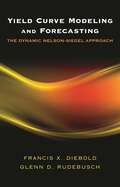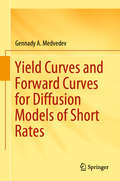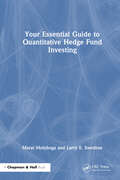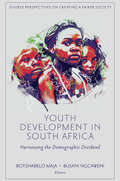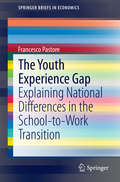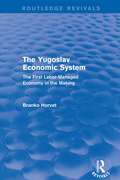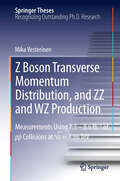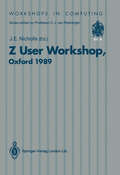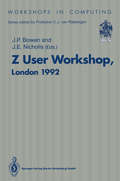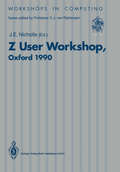- Table View
- List View
Yield Curve Modeling and Forecasting: The Dynamic Nelson-Siegel Approach
by Francis X. Diebold Glenn D. RudebuschUnderstanding the dynamic evolution of the yield curve is critical to many financial tasks, including pricing financial assets and their derivatives, managing financial risk, allocating portfolios, structuring fiscal debt, conducting monetary policy, and valuing capital goods. Unfortunately, most yield curve models tend to be theoretically rigorous but empirically disappointing, or empirically successful but theoretically lacking. In this book, Francis Diebold and Glenn Rudebusch propose two extensions of the classic yield curve model of Nelson and Siegel that are both theoretically rigorous and empirically successful. The first extension is the dynamic Nelson-Siegel model (DNS), while the second takes this dynamic version and makes it arbitrage-free (AFNS). Diebold and Rudebusch show how these two models are just slightly different implementations of a single unified approach to dynamic yield curve modeling and forecasting. They emphasize both descriptive and efficient-markets aspects, they pay special attention to the links between the yield curve and macroeconomic fundamentals, and they show why DNS and AFNS are likely to remain of lasting appeal even as alternative arbitrage-free models are developed. Based on the Econometric and Tinbergen Institutes Lectures, Yield Curve Modeling and Forecasting contains essential tools with enhanced utility for academics, central banks, governments, and industry.
Yield Curve Modeling and Forecasting: The Dynamic Nelson-Siegel Approach
by Francis X. Diebold Glenn D. RudebuschUnderstanding the dynamic evolution of the yield curve is critical to many financial tasks, including pricing financial assets and their derivatives, managing financial risk, allocating portfolios, structuring fiscal debt, conducting monetary policy, and valuing capital goods. Unfortunately, most yield curve models tend to be theoretically rigorous but empirically disappointing, or empirically successful but theoretically lacking. In this book, Francis Diebold and Glenn Rudebusch propose two extensions of the classic yield curve model of Nelson and Siegel that are both theoretically rigorous and empirically successful. The first extension is the dynamic Nelson-Siegel model (DNS), while the second takes this dynamic version and makes it arbitrage-free (AFNS). Diebold and Rudebusch show how these two models are just slightly different implementations of a single unified approach to dynamic yield curve modeling and forecasting. They emphasize both descriptive and efficient-markets aspects, they pay special attention to the links between the yield curve and macroeconomic fundamentals, and they show why DNS and AFNS are likely to remain of lasting appeal even as alternative arbitrage-free models are developed. Based on the Econometric and Tinbergen Institutes Lectures, Yield Curve Modeling and Forecasting contains essential tools with enhanced utility for academics, central banks, governments, and industry.
Yield Curves and Forward Curves for Diffusion Models of Short Rates
by Gennady A. MedvedevThis book is dedicated to the study of the term structures of the yields of zero-coupon bonds. The methods it describes differ from those usually found in the literature in that the time variable is not the term to maturity but the interest rate duration, or another convenient non-linear transformation of terms. This makes it possible to consider yield curves not only for a limited interval of term values, but also for the entire positive semiaxis of terms. The main focus is the comparative analysis of yield curves and forward curves and the analytical study of their features. Generalizations of yield term structures are studied where the dimension of the state space of the financial market is increased. In cases where the analytical approach is too cumbersome, or impossible, numerical techniques are used. This book will be of interest to financial analysts, financial market researchers, graduate students and PhD students.
Yosida Approximations of Stochastic Differential Equations in Infinite Dimensions and Applications (Probability Theory and Stochastic Modelling #79)
by T. E. GovindanThis research monograph brings together, for the first time, the varied literature on Yosida approximations of stochastic differential equations (SDEs) in infinite dimensions and their applications into a single cohesive work. The author provides a clear and systematic introduction to the Yosida approximation method and justifies its power by presenting its applications in some practical topics such as stochastic stability and stochastic optimal control. The theory assimilated spans more than 35 years of mathematics, but is developed slowly and methodically in digestible pieces.The book begins with a motivational chapter that introduces the reader to several different models that play recurring roles throughout the book as the theory is unfolded, and invites readers from different disciplines to see immediately that the effort required to work through the theory that follows is worthwhile. From there, the author presents the necessary prerequisite material, and then launches the reader into the main discussion of the monograph, namely, Yosida approximations of SDEs, Yosida approximations of SDEs with Poisson jumps, and their applications. Most of the results considered in the main chapters appear for the first time in a book form, and contain illustrative examples on stochastic partial differential equations. The key steps are included in all proofs, especially the various estimates, which help the reader to get a true feel for the theory of Yosida approximations and their use.This work is intended for researchers and graduate students in mathematics specializing in probability theory and will appeal to numerical analysts, engineers, physicists and practitioners in finance who want to apply the theory of stochastic evolution equations. Since the approach is based mainly in semigroup theory, it is amenable to a wide audience including non-specialists in stochastic processes.
A Young Generation Under Pressure?: The Financial Situation and the "Rush Hour" of the Cohorts 1970 - 1985 in a Generational Comparison
by Joerg Chet TremmelJustice between generations is still not as prominent on any agenda as justice between rich and poor or men and women. For the first time, this three-part book explores the situation of young people of today in comparison to their direct predecessors. The first part, The Financial Situation of the Young Generation in a Generational Comparison, deals with this generation's financial standing; the second part, The Rush Hour of Life, examines their time restrictions. Both are considered from a life-course perspective. The third part, On the Path to Gerontocracy?, addresses the demographic shift in favor of the elderly in aging Western democracies.
Young Geographers: Showcasing Research Contributions in Geography (Key Challenges in Geography)
by Gert Ruepert Tijana IlićThis book shows an updated overview of research about human geography topics like urban growth/urban challenges, transportation, landscape, land cover, geospatial analysis, regional planning/local development, cultural geography, tourism, and so on. Between 2020 and 2022, due to COVID-19 and lockdowns worldwide, there were fewer opportunities for young and upcoming researchers to present their state-of-the-art findings at conferences. In order to highlight exceptional research of young geographers during this time, the idea for this book was created. In collaboration with the EGEA alumni foundation for students and young geographers, 12 authors were selected to showcase their scientific work. In addition to that, most of them present amazing maps and figures as outstanding expression of the need of GIS for geography research.
Young Measures on Topological Spaces: With Applications in Control Theory and Probability Theory (Mathematics and Its Applications #571)
by Charles Castaing Paul Raynaud de Fitte Michel ValadierYoungsters Solving Mathematical Problems with Technology: The Results and Implications of the Problem@Web Project (Mathematics Education in the Digital Era #5)
by Susana Carreira Keith Jones Nélia Amado Hélia Jacinto Sandra NobreThis book contributes to both mathematical problem solving and the communication of mathematics by students, and the role of personal and home technologies in learning beyond school. It does this by reporting on major results and implications of the Problem@Web project that investigated youngsters’ mathematical problem solving and, in particular, their use of digital technologies in tackling, and communicating the results of their problem solving, in environments beyond school. The book has two focuses: Mathematical problem solving skills and strategies, forms of representing and expressing mathematical thinking, technological-based solutions; and students´ and teachers´ perspectives on mathematics learning, especially school compared to beyond-school mathematics.
Your Essential Guide to Quantitative Hedge Fund Investing
by Marat Molyboga Larry E. SwedroeYour Essential Guide to Quantitative Hedge Fund Investing provides a conceptual framework for understanding effective hedge fund investment strategies. The book offers a mathematically rigorous exploration of different topics, framed in an easy to digest set of examples and analogies, including stories from some legendary hedge fund investors. Readers will be guided from the historical to the cutting edge, while building a framework of understanding that encompasses it all. Features Filled with novel examples and analogies from within and beyond the world of finance Suitable for practitioners and graduate-level students with a passion for understanding the complexities that lie behind the raw mechanics of quantitative hedge fund investment A unique insight from an author with experience of both the practical and academic spheres.
Your Essential Guide to Quantitative Hedge Fund Investing
by Marat Molyboga Larry E. SwedroeYour Essential Guide to Quantitative Hedge Fund Investing provides a conceptual framework for understanding effective hedge fund investment strategies. The book offers a mathematically rigorous exploration of different topics, framed in an easy to digest set of examples and analogies, including stories from some legendary hedge fund investors. Readers will be guided from the historical to the cutting edge, while building a framework of understanding that encompasses it all. Features Filled with novel examples and analogies from within and beyond the world of finance Suitable for practitioners and graduate-level students with a passion for understanding the complexities that lie behind the raw mechanics of quantitative hedge fund investment A unique insight from an author with experience of both the practical and academic spheres.
Your Number's Up: Digits, number lines, negative and positive numbers (Maths is Everywhere #1)
by Rob ColsonNumbers are all around us but why are they important? This book finds out what numbers are, from how we count them, to what are prime and base numbers and takes you upto the really big ones - millions, billions and to infinity and beyond. You'll also explore some really strange numbers, find out about your body in numbers and get to grips with roman numerals. Plus, there are fun quizzes to help you test your knowledge.The book is part of the Maths is Everywhere series, which demystifies all aspects of maths and shows how it relates to your everyday world with fun, colourful graphics. These are fantastic books for children aged nine plus who are studying maths, or for anyone who wants to get to grips with maths in a fun way.
Your Undergraduate Psychology Project: A Student Guide
by Mark ForshawYour Undergraduate Psychology Project: A Student Guide has been designed with the needs of the student in mind. Packed with hints and tips, and written in a simple, informal style, this ‘second supervisor’ is designed to ease students further into the world of research. The second edition has been completely revised and updated with new material on focus groups and ethics and a new section entitled How to Lose Marks Instantly Structured chronologically around planning a project, carrying it out, and then writing it up. Gives practical advice on how to deal with day-to-day problems such as software failures or uncommunicative interviewees. Written in consultation with a number of experienced academics and students of psychology.
Youth Development in South Africa: Harnessing the Demographic Dividend (Diverse Perspectives on Creating a Fairer Society)
by Botshabelo Maja and Busani NgcaweniThe African continent is colloquially referred to as the youngest in the world. Seizing on a topic underexplored in African research, Youth Development in South Africa: Harnessing the Demographic Dividend confronts the issues, challenges, and opportunities facing South Africa’s youth, resulting in a rich exploration of the South African corpus on youth development. Bringing together a diverse range of topics and research methodologies, contributors focus on the demographic dividend, South Africa’s relatively large population of young people, and the implications of harnessing this for economic growth and development within this country. Analysing model institutional and policy initiatives for youth development, contributors present a unique translation of ideas into practice, as well as attention to solutions. Highlighting challenges such as health pandemics, social media, and climate change, chapters cover questions surrounding youth aspirations, employment, and inclusivity. Showcasing the voices of researchers from across South Africa and the larger African continent, Youth Development in South Africa: Harnessing the Demographic Dividend is a compelling snapshot of thirty years of South Africa’s democratic dispensation and what it has meant for the youth of the country, as well as how its demographic dividend can be harnessed for a fairer society in the future.
Youth Development in South Africa: Harnessing the Demographic Dividend (Diverse Perspectives on Creating a Fairer Society)
by Botshabelo Maja Busani NgcaweniThe African continent is colloquially referred to as the youngest in the world. Seizing on a topic underexplored in African research, Youth Development in South Africa: Harnessing the Demographic Dividend confronts the issues, challenges, and opportunities facing South Africa’s youth, resulting in a rich exploration of the South African corpus on youth development. Bringing together a diverse range of topics and research methodologies, contributors focus on the demographic dividend, South Africa’s relatively large population of young people, and the implications of harnessing this for economic growth and development within this country. Analysing model institutional and policy initiatives for youth development, contributors present a unique translation of ideas into practice, as well as attention to solutions. Highlighting challenges such as health pandemics, social media, and climate change, chapters cover questions surrounding youth aspirations, employment, and inclusivity. Showcasing the voices of researchers from across South Africa and the larger African continent, Youth Development in South Africa: Harnessing the Demographic Dividend is a compelling snapshot of thirty years of South Africa’s democratic dispensation and what it has meant for the youth of the country, as well as how its demographic dividend can be harnessed for a fairer society in the future.
The Youth Experience Gap: Explaining National Differences in the School-to-Work Transition (SpringerBriefs in Economics)
by Francesco Pastore“The education to work transition of young people is key to a successful work-life and to fight youth unemployment. The book provides an impressive outline of the facts and convincing insights of the potential causes. This offers a large and broader audience help to adjust properly to achieve a better life.”Klaus F. Zimmermann, IZA, Bonn, GermanyThis work points to the youth experience gap as a key concept to explain the meager employment opportunities and earnings many young people face.The transition from education to work remains a long dark tunnel around the world. However, this book shows that there are striking differences between countries: in Germany, the young people of today are no worse off than their adult counterparts, while in Southern European and Eastern European countries they fare 3 through 4 times worse.The current economic and financial crisis has further exacerbated the situation for young people in many advanced economies. Observers are divided as to the optimal design of youth employment policy. Liberalists believe that the market itself should address youth disadvantages. More flexible labor markets should also guarantee greater labor turnover, including temporary work, so as to allow young people to move from one job to the next until they accumulate the work experience they need to become more employable and find the right career. In contrast, other economists oppose approaches focusing on entry flexibility and temporary work, claiming that the former type helps only the most skilled and motivated target groups, while the latter only allows young people to gather generic, not job-specific work experience.
Youth in India: Aspirations, Attitudes, Anxieties
by Sanjay KumarThis book explores the attitudes, anxieties and aspirations of India’s burgeoning young population in a globalised world. Drawing upon time-series survey data of the Indian youth aged between 15 and 34 years across 19 Indian states, it provides key insights into a range of themes along with an overview of the changing trends and patterns of their behaviour. The volume examines the job preferences of the Indian youth, their career priorities and opinions on reservations in employment and education sectors. It measures their degree of political participation and studies their attitude regarding political issues. It looks at aspects relating to their social and cultural contexts, preferences and practices, including lifestyle choices, consumption habits and social customs such as marriage, as they negotiate between tradition and modernity. Further, it discusses the anxieties and insecurities that the youth face, their mental health and their experiences of social discrimination. The essays here offer an understanding of a critical demographic and shed light on the challenges and opportunities that the Indian youth confront today. Lucid, accessible and empirically grounded, this volume will be useful to scholars and researchers of sociology, political sociology, political studies, youth psychology and anthropology as well as policymakers, journalists and the interested general reader.
Youth in India: Aspirations, Attitudes, Anxieties
by Sanjay KumarThis book explores the attitudes, anxieties and aspirations of India’s burgeoning young population in a globalised world. Drawing upon time-series survey data of the Indian youth aged between 15 and 34 years across 19 Indian states, it provides key insights into a range of themes along with an overview of the changing trends and patterns of their behaviour. The volume examines the job preferences of the Indian youth, their career priorities and opinions on reservations in employment and education sectors. It measures their degree of political participation and studies their attitude regarding political issues. It looks at aspects relating to their social and cultural contexts, preferences and practices, including lifestyle choices, consumption habits and social customs such as marriage, as they negotiate between tradition and modernity. Further, it discusses the anxieties and insecurities that the youth face, their mental health and their experiences of social discrimination. The essays here offer an understanding of a critical demographic and shed light on the challenges and opportunities that the Indian youth confront today. Lucid, accessible and empirically grounded, this volume will be useful to scholars and researchers of sociology, political sociology, political studies, youth psychology and anthropology as well as policymakers, journalists and the interested general reader.
Youthquake: Why African Demography Should Matter to the World
by Edward PaiceA riveting study of Africa's demographics – its youth and growth – and what they mean for the continent, today and into the future. 'Essential reading' Guardian 'Intensely researched – and very important!' The Week 'The research in Youthquake is meticulous' Tim Marshall, Reaction 'Attempts to end the hysteria and ignorance surrounding demographic trends' New Statesman 'Meticulously researched, nuanced and brilliant' Mary HarperAfrica's population growth in the last 50 years has been unprecedented. By mid-century, the continent will make up a quarter of the global population, compared to one-tenth in 1980. Africa's youth is the most striking aspect of its demography. As the rest of the world ages, almost 60 per cent of Africa's population is younger than 25 years old. This 'youthquake' will have immense consequences for the social, economic and political reality in Africa. Edward Paice presents a detailed, nuanced analysis of the varied demography of Africa. He rejects the fanciful over-optimism of some commentators and doom-laden prophecies of others, while scrutinising received wisdom, and carefully considering the ramifications of the youthquake for Africa and the world.
The Yugoslav Economic System (Routledge Revivals): The First Labor-Managed Economy in the Making
by Branko HorvatFirst published in 1976, this book traces the development of the Yugoslav economy from the end of the Second World War to the beginning of 1975, which the author argues was a highly productive era of social innovation. Drawing on personal experience of the Revolution, the Partisan Liberation War and his time as a member of the Federal Planning Board as well as a comprehensive array of written sources, the author attempts to understand the development process, compare policy proclamations with achieved results, study the theories and ideas that led a to certain policy, distinguish the economic and political ingredients in decision making and analyses the causes of success and failure.
The Yugoslav Economic System (Routledge Revivals): The First Labor-Managed Economy in the Making
by Branko HorvatFirst published in 1976, this book traces the development of the Yugoslav economy from the end of the Second World War to the beginning of 1975, which the author argues was a highly productive era of social innovation. Drawing on personal experience of the Revolution, the Partisan Liberation War and his time as a member of the Federal Planning Board as well as a comprehensive array of written sources, the author attempts to understand the development process, compare policy proclamations with achieved results, study the theories and ideas that led a to certain policy, distinguish the economic and political ingredients in decision making and analyses the causes of success and failure.
Z Boson Transverse Momentum Distribution, and ZZ and WZ Production: Measurements Using 7.3 – 8.6 fb–1 of p¯p Collisions at √s = 1.96 TeV (Springer Theses)
by Mika VesterinenThis work develops novel data analysis techniques enabling aspects of the Standard Model of particle physics to be tested with unprecedented precision using data from the DZero experiment at the high energy “Tevatron” proton-antiproton collider at Fermilab, Chicago. Vesterinen's measurements of the transverse momentum of Z bosons using the novel variable φ* have exposed deficiencies in the current state-of-the-art theoretical predictions for vector boson production at hadron colliders. These techniques are now being used in the experiments at CERN’s Large Hadron Collider (LHC) and have stimulated considerable interest in the theoretical particle physics community. Furthermore, Vesterinen's measurements of the cross sections for the production of pairs of vector bosons (WZ and ZZ) are to date the most precise ever made.
Z° Physics: Cargèse 1990 (Nato Science Series B: #261)
by Maurice Lévy Jean-Louis Basdevant Maurice Jacob David Speiser Jacques Weyers Raymond GastmansProceedings of a NATO ASI held in Cargese, France, August 13--25, 1990
Z User Workshop: Proceedings of the Fourth Annual Z User Meeting Oxford, 15 December 1989 (Workshops in Computing)
by John E. NichollsThe mathematical concepts and notational conventions we know of as Z were first proposed around 1981. Its origins were in line with the objectives of the PRG - to establish a mathematical basis for program ming concepts and to verify the work by case studies with industry. Hence among early Z users some were from academic circles, with interests in the mathematical basis of programming; others came from industry and were involved with pilot projects and case studies linked with the Programming Research Group. Four years ago we had the first Z User Meeting, a fairly modest affair with representatives more or less equally divided between academia and industry. At the first meeting there were, as in this meeting, a variety of technical papers, reports of work in progress and discussions. A number of people from industry came along, either because they had begun to use Z or were curious about the new direction. In the discussion sessions at the end of the meeting, there were calls from attendees for the establishment of a more stable base for the notation, including work on its documentation and standards. Many of these requests have now been satisfied and the notation is now being proposed for standards development.
Z User Workshop, London 1992: Proceedings of the Seventh Annual Z User Meeting, London 14–15 December 1992 (Workshops in Computing)
by J. P. Bowen J. E. NichollsThe Z notation has been developed at the Programming Research Group at the Oxford University Computing Laboratory and elsewhere for over a decade. It is now used by industry as part of the software (and hardware) development process in both Europe and the USA. It is currently undergoing BSI standardisation in the UK, and has been proposed for ISO standardisation internationally. In recent years researchers have begun to focus increasingly on the development of techniques and tools to encourage the wider application of Z and other formal methods and notations. This volume contains papers from the Seventh Annual Z User Meeting, held in London in December 1992. In contrast to previous years the meeting concentrated specifically on industrial applications of Z, and a high proportion of the participants came from an industrial background. The theme is well represented by the four invited papers. Three of these discuss ways in which formal methods are being introduced, and the fourth presents an international survey of industrial applications. It also provides a reminder of the improvements which are needed to make these methods an accepted part of software development. In addition the volume contains several submitted papers on the industrial use of Z, two of which discuss the key area of safety-critical applications. There are also a number of papers related to the recently-completed ZIP project. The papers cover all the main areas of the project including methods, tools, and the development of a Z Standard, the first publicly-available version of which was made available at the meeting. Finally the volume contains a select Z bibliography, and section on how to access information on Z through comp.specification.z, the international, computer-based USENET newsgroup. Z User Workshop, London 1992 provides an important overview of current research into industrial applications of Z, and will provide invaluable reading for researchers, postgraduate students and also potential industrial users of Z.
